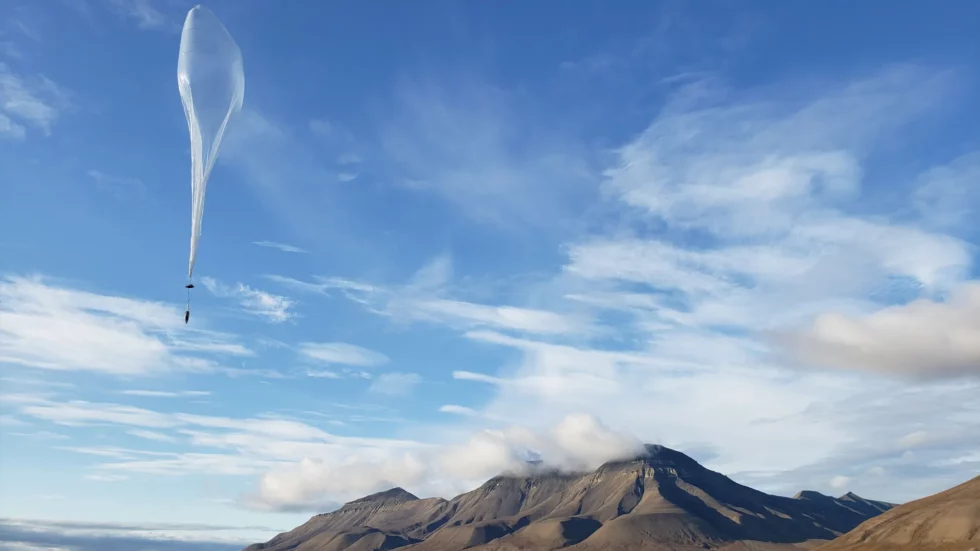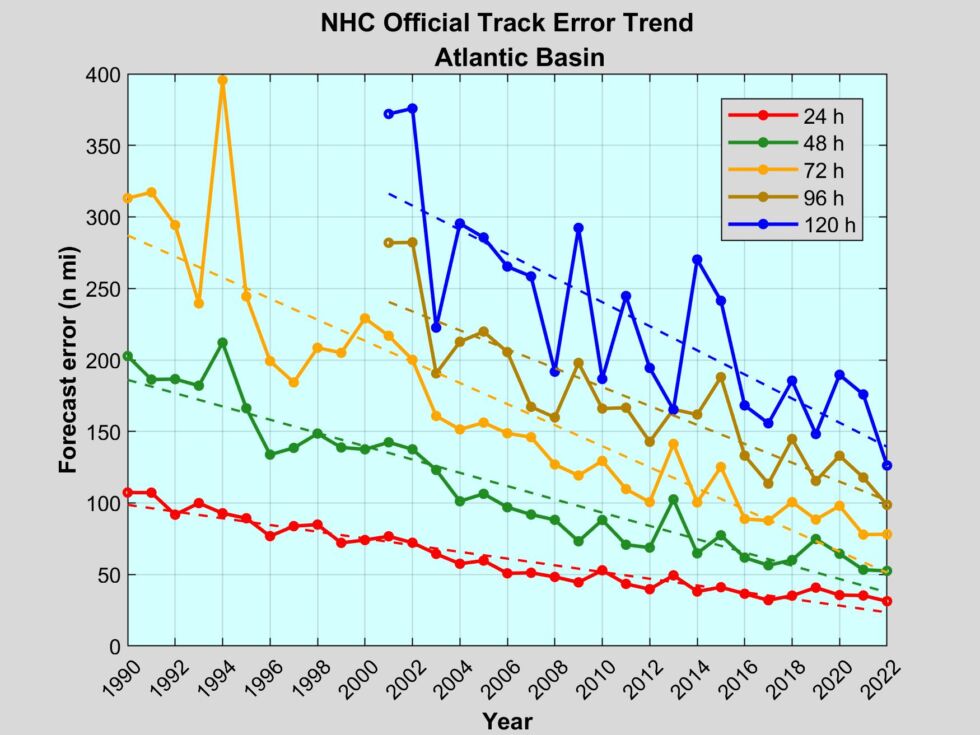New model that predicts global weather can run on a single desktop computer.

Much like the invigorating passage of a strong cold front, major changes are afoot in the weather forecasting community. And the end game is nothing short of revolutionary: an entirely new way to forecast weather based on artificial intelligence that can run on a desktop computer.
Today’s artificial intelligence systems require one resource more than any other to operate—data. For example, large language models such as ChatGPT voraciously consume data to improve answers to queries. The more and higher quality data, the better their training, and the sharper the results.
However, there is a finite limit to quality data, even on the Internet. These large language models have hoovered up so much data that they’re being sued widely for copyright infringement. And as they’re running out of data, the operators of these AI models are turning to ideas such as synthetic data to keep feeding the beast and produce ever more capable results for users.
If data is king, what about other applications for AI technology similar to large language models? Are there untapped pools of data? One of the most promising that has emerged in the last 18 months is weather forecasting, and recent advances have sent shockwaves through the field of meteorology.
That’s because there’s a secret weapon: an extremely rich data set. The European Centre for Medium-Range Weather Forecasts, the premiere organization in the world for numerical weather prediction, maintains a set of data about atmospheric, land, and oceanic weather data for every day, at points around the world, every few hours, going back to 1940. The last 50 years of data, after the advent of global satellite coverage, is especially rich. This dataset is known as ERA5, and it is publicly available.Advertisement
It was not created to fuel AI applications, but ERA5 has turned out to be incredibly useful for this purpose. Computer scientists only really got serious about using this data to train AI models to forecast the weather in 2022. Since then, the technology has made rapid strides. In some cases, the output of these models is already superior to global weather models that scientists have labored decades to design and build, and they require some of the most powerful supercomputers in the world to run.
“It is clear that machine learning is a significant part of the future of weather forecasting,” said Matthew Chantry, who leads AI forecasting efforts at the European weather center known as ECMWF, in an interview with Ars.
It’s moving fast
John Dean and Kai Marshland met as undergraduates at Stanford University in the late 2010s. Dean, an electrical engineer, interned at SpaceX during the summer of 2017. Marshland, a computer scientist, interned at the launch company the next summer. Both graduated in 2019 and were trying to figure out what to do with their lives.
“We decided we wanted to solve the problem of weather uncertainty,” Marshland said, so they co-founded a company called WindBorne Systems.
The premise of the company was simple: For about 85 percent of the Earth and its atmosphere, we have no good data about weather conditions there. A lack of quality data, which establishes initial conditions, represents a major handicap for global weather forecast models. The company’s proposed solution was in its name—wind borne.
Dean and Marshland set about designing small weather balloons they could release into the atmosphere and which would fly around the world for up to 40 days, relaying useful atmospheric data that could be packaged and sold to large, government-funded weather models.
Weather balloons provide invaluable data about atmospheric conditions—readings such as temperature, dewpoints, and pressures—that cannot be captured by surface observations or satellites. Such atmospheric “profiles” are helpful in setting the initial conditions models start with. The problem is that traditional weather balloons are cumbersome and only operate for a few hours. Because of this, the National Weather Service only launches them twice daily from about 100 locations in the United States.
ARS VIDEO
What Happens to the Developers When AI Can Code? | Ars Frontiers

Dean and Marshland developed much smaller balloons, each with a mass of less than 6 pounds and designed to persist in the atmosphere for weeks. By launching hundreds a day, over time, they can accrue data from around the world. WindBorne now operates the largest atmospheric balloon constellation in the world, Marshland said.
To test the assimilation of this balloon data into forecast models, WindBorne began to develop its own weather model about a year ago. It chose to experiment with AI forecasting because traditional models, based on complex computational physics, require an extraordinary amount of computing power.
“When we started to develop AI forecasting, I didn’t think it would be a more accurate model,” Dean said. “It was a way to save computing power. A single desktop computer with a high-powered GPU can run it. That is insane compared to the compute power used for global forecast models.”
Pretty soon, however, the company’s AI weather model, WeatherMesh, was performing better than traditional, physics-based models on tasks such as hurricane forecasting.
“It was mind-blowing how incredibly well it worked,” Dean said.
WindBorne now offers two products to customers: balloon data and an impressively accurate deep-learning model.
Origins of AI forecasting
Some early academic work on using deep learning techniques for weather forecasting began about six years ago. This form of machine learning is based on neural networks, essentially connected nodes that are layered in a manner inspired by biological brains. By ingesting data, neural networks can be “trained” to identify and classify information and recognize patterns and possibilities.
Computer scientists were not overly optimistic that this approach would work because it was so wildly different from the science of weather forecasting that had been developed over decades. Traditional modeling uses complex physical equations to simulate the fluidic motion of the atmosphere. The most powerful global models take a set of initial weather conditions and then crunch through these equations to provide point forecasts for a grid a few miles across, out to 16 days, around the world.Advertisement
The ECMWF model is the best physics-based model in the world, although other countries, including the United States, Canada, and Japan, also run global weather models for various forecasting purposes.
The initial skepticism about AI models was eased in 2022. A physicist and data scientist named Ryan Keisler presented some promising initial returns with what he called “graph neural networks.” Shortly afterward, scientists from the China-based Huawei multinational company released information about their efforts to develop the “Pangu-Weather” model. These initial results, later published in Nature, found that under certain circumstances, the Chinese deep-learning model outperformed even the physics-based ECMWF model.
This sent a shockwave through the small community of scientists working with deep learning techniques and weather modeling. Chantry and the European weather center were among those paying attention as other models, such as Google’s GraphCast, were released with similar promise. In early 2023, Chantry and a few colleagues began to study the possibilities, and in the summer of 2023, the member nations that fund the center agreed to support the development of a model.
The AI-focused team remained small compared to the developers who worked on the physics-based model, partly because this approach required fewer resources. Radically fewer, in fact. WindBorne, which developed the WeatherMesh model, is a company of about two dozen people. Its model can run on a single, powerful desktop computer.
The European scientists set to work making an operational model based on the work of the other deep learning models. It didn’t take long. By the end of last year, the new Artificial Intelligence/Integrated Forecasting System, or AIFS, was already producing “very promising” results. This spring, the European forecasters started to publish real-time forecasts. As a meteorologist working in the field today, I use them and find them to be an increasingly useful tool.
But as someone who is not particularly literate in artificial intelligence technology, I was eager to find out how they worked. If I’m going to rely on this tool, I’d like to understand what I’m using.
How they work
The first thing to understand about a deep-learning forecast model is that it uses no physics-based modeling of the atmosphere at all. It is also not a large language model. “It is not like asking Chat GPT to predict the weather,” Chantry said.
Essentially, a deep-learning model works by learning. A snapshot of the Earth and its weather conditions is shown to the model—values like temperature, pressure, humidity, winds, and much more at various levels of the atmosphere. Then the model is shown what conditions were like six hours later around the Earth. The model then “learns” this relationship between weather now and conditions a few hours later.
The process is repeated many times over. This is where the ERA5 data is incredibly valuable. It has nearly six decades of high-quality data for every day, every few hours, and for points all around the world. By ingesting all this data, the model gets better and better at recognizing patterns and making connections about conditions now—say, a large, low-pressure system over the Northern Atlantic Ocean—and what that means for weather downstream over Europe and Asia over the coming week to 10 days.
One of the initial concerns about this approach was whether there was enough data in ERA5 to make robust forecasts. But given the improving performance of the models, it appears there is indeed enough information.Advertisement
Part of the challenge for Chantry and his colleagues is identifying what works well with the AIFS model and what needs improvement. For example, deep learning weather models have proven to be excellent at forecasting the tracks of hurricanes. But while these models are better at predicting where hurricanes will go, they tend to be lower-performing on the intensity changes of such storms relative to physics-based models.
For now, physics-based weather models aren’t going anywhere. They’re incredibly powerful tools that have significantly improved our ability to make five-, seven- and occasionally even 10-day weather forecasts for major events. They’re trusted by forecasters around the world. But what does the future look like?
The first step is potentially changing the way data is assimilated into AI-based models. At present, they almost universally use a set of initial conditions produced by a physics model. That is, a model like the ECMWF spends an enormous amount of computing power to collect data from buoys, surface stations, weather balloons, airplanes, ships, satellites, and many other sources and then synthesizes a set of initial conditions for grid points across the planet. All models then take this as the beginning “state” of the planet’s weather and forecast from that.
However, Chantry and others are working on techniques for AI models to ingest current observations and thereby perform both the data assimilation and forecasting parts of weather modeling. This, he says, is actually a harder problem than training AI models.
“That version is the completely revolutionary version,” he said. “It’s a fascinating research topic that flips the table over.”
Something like that may be possible a decade from now.
What all this means
I started writing about the weather about 20 years ago, and the modeling tools we had back then were fairly simple. You had a few different kinds of models, and they were generally not very good. With major hurricanes like Katrina, there was a ton of uncertainty about where they would go. At the time, the average positional error in a five-day forecast was about 425 miles, about the distance from New York City to Bangor, Maine.
Today, that error is fewer than 200 miles. It’s far from perfect, but it’s a huge difference. Further improvements would help narrow down evacuation areas, saving an incredible amount of time, money, and heartache.
The Atlantic hurricane season officially began on June 1, and it’s expected to be a rather busy one. A good forecaster looks at many different models and understands that for any particular storm, one model may handle the atmospheric setup better than others. As we get into the season, I’m looking at Chantry’s AIFS model as one of those tools and will evaluate its performance.

However, such AI models have not entirely entered the mainstream. Some of the best forecasters in the world work for the National Hurricane Center in Miami. This is the office within NOAA that is charged with forecasting hurricanes and issuing warnings for the entire Atlantic basin, including the United States. Having observed their work closely for a quarter of a century, they’re fantastic.
This year, forecasters at the center will not be using the AI models for operational forecasts, a source told Ars. These are the official forecasts that include the familiar “cone of uncertainty” and warning areas. However, forecasters will be evaluating the new tools.
This is the first Atlantic hurricane season in which many of these new models will be fully available in real time. It’s one thing to perform well on tests or in a “hindcast,” where a model is tested on past operational data. It’s another to make actionable predictions.
So in the coming months, on one of the biggest stages imaginable—a blockbuster Atlantic hurricane season where storms may threaten some of the largest cities in the United States—models such as AIFS, WeatherMesh, and others will have a chance to strut their stuff in real time.
We’ll be watching closely.




